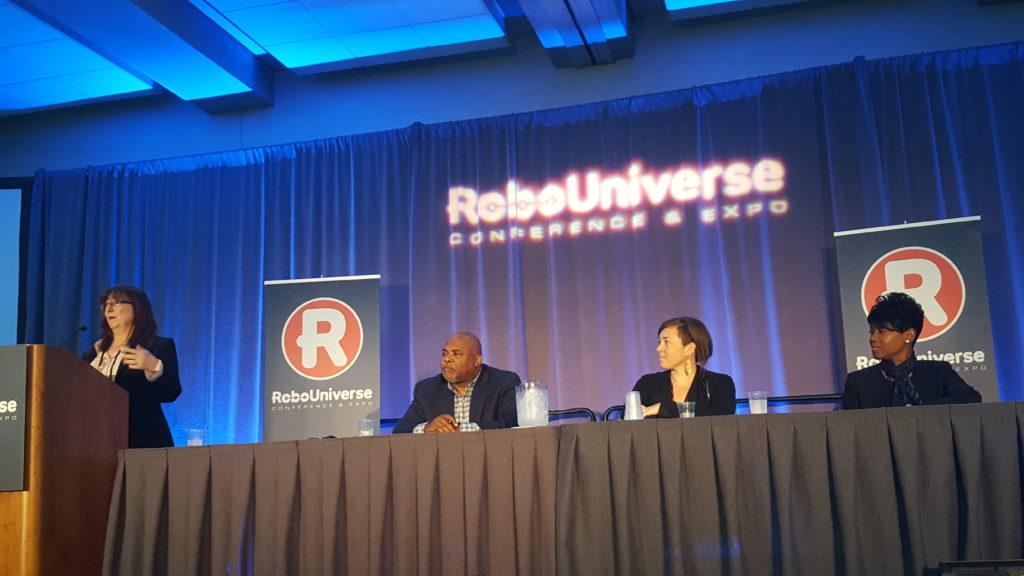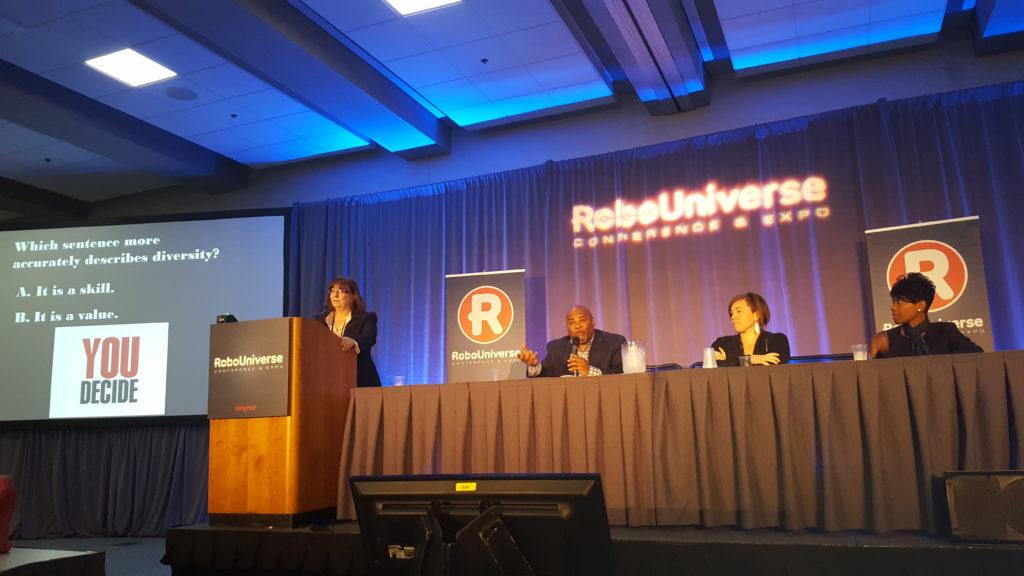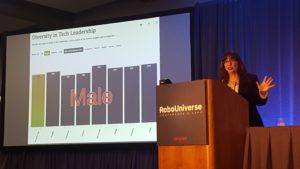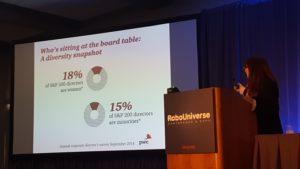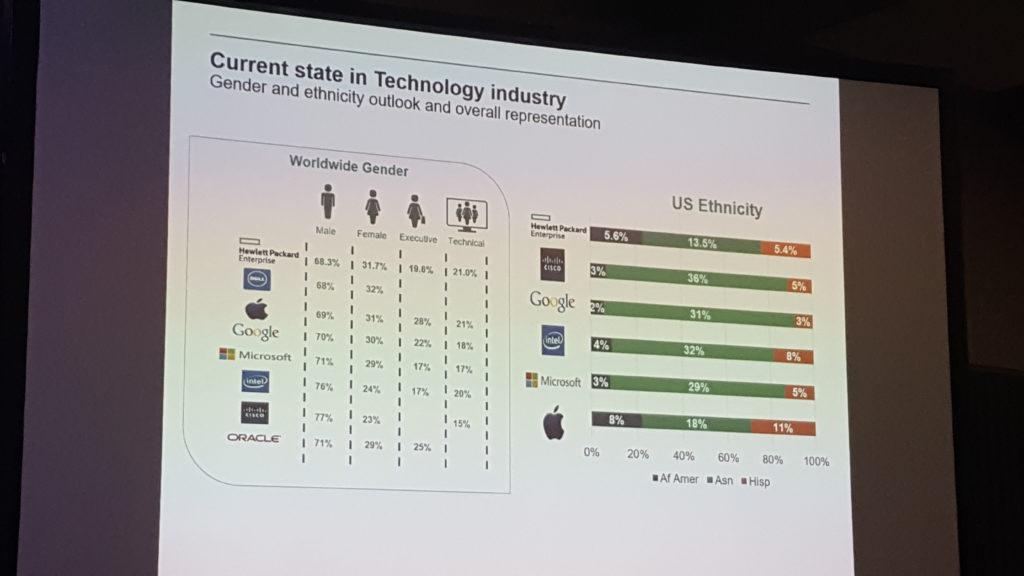One panel I had been anticipating ahead of Inside 3D Printing San Diego this week was Thursday afternoon’s panel on diversity, set to examine an important issue that is often coming to the fore in technological fields: “Diversity in Frontier Tech: Should diversity be a priority for the technology sector?”
Rising Media initially announced a newly founded diversity committee to ensure that all future events will feature much-needed diversity in the presenters who share their insights with us at all of the Frontier Tech Forum shows. This commitment to ensuring diversity marks an important step forward in bringing all of the varied voices to the forefront in events showcasing the best and brightest in the latest tech. The panel, moderated by Adriana Vela, Founder and Chair of NanoTecNexus, featured speakers Steven Jones, CEO, Jones Inclusive; Meisha Sherman, Global Senior Director, Executive Leadership & Organization Development, Hewlett Packard Enterprise; and Kate McAndrew, Investment, Bolt. Nora Toure, Founder, Women in 3D Printing, was additionally on the committee behind Thursday’s panel.
“Diversity goes beyond just gender or race or sexual orientation,” Vela opened, while showcasing diversity plans from Nissan and Northrop Grumman. “Now where does the tech industry stack up against these, based on just one marker — gender? There are some that are fairly balanced, and others that have a lot of work to do because they’re nowhere near there.”
Looking at general makeup as well as leadership makeup between male and female executives and board tables, we could see that the graphs she shared showed a very marked disparity. Diversity is now being seen as a strong business driver, Vela noted, as more companies begin to pay attention to disparities long existent in these fields.
“Is it all great good news? Well, no. There’s been a lot of research in this area, including that published in the Harvard Business Review, with a lot of initiatives that are backfiring, that are simply not working, that are being done all wrong. Clearly nobody wants that. Why is that?”
To examine these issues and the whys behind them, Vela proceeded to introduce the panelists present, who each brought varied backgrounds and experiences to share. Vela opened the conversation by asking each panelist to define diversity as well as where they got it right and wrong. Listen to their responses in this video:
The conversation turned next to workplace environments and the complacency that can appear.
“Is diversity a problem if our portfolio is still performing?” McAndrew noted of a common question in investments. “If the team is full of white dudes, is that a problem?”
Yes — because it could still be “leaving money on the table” by not utilizing the best resources possible.
“What’s the level of engagement in the culture? What’s the level of trust in the culture? What’s the level of risk of retribution in the culture?” Dr. Jones pointed out some of the key questions to ask regarding bringing diversity concerns up in the workplace.
Using NASA’s Challenger explosion as an example, Dr. Jones noted that digging in revealed that some answers could have been found among the lower ranks of the organization at the time. When asked why they didn’t speak up, the response was simply: “Haven’t you heard of the CLM?” That CLM — career limiting move — is a real concern for those not perceived to be in a position to respond to high-level matters.
“What’s happening in the environment? What’s not happening in the environment?” Sherman asked of awareness in a workplace.
“The framing of the problem is part of the problem that many organizations have with diversity. When we frame the issue that diversity is only a problem to solve, we lose leverage,” Dr. Jones added. “What are we leaving on the table, as Kate said? That’s the benefit of diversity, as Meisha’s point about compliance — I’m doing this because I have to — is different than the context of I’m doing this because I want to. We need to shift the narrative, how do we shift the focus to diversity as leverage rather than a problem to solve?”
Vela then asked the audience:
Which sentence more accurately describes diversity?
- A. It is a skill
- B. It is a value.
The vast majority voted for option B. Dr. Jones responded to this vote by saying:
“We say that diversity is both a value and a skill. The idea of value is what motivates me to put something into action. The behaviors that make people feel valued and respected. It’s important to frame diversity as a skill set as well is that I know people with the best of intentions — we get into a space of unconscious bias. I can have the value to be fair, but we say: if you have a brain, you have bias. Having a value alone does not allow me to deliver on the end result of inclusion and greater diversity if I do not put skills and behaviors, policies and procedures in place to deliver in that value.”
Sherman added the point of “both and” — necessitating the need for both skills and value. McAndrew contributed her experience with a venture firm that recently wanted to invest in diversity. Given a playbook with a clear-cut plan, though, nothing happened. The implementation was not there, though the thought had been behind it.
“The whole idea of this being a skill was new to me,” Vela said. “Like coding or branding, it’s a skill, it can be learned. I became less defensive — this is just another tool that I can learn. That was huge for me, as far as learning.”
The panel turned next to what kinds of training could make diversity implementation successful.
“All leaders are diversity leaders. If you are running a team, you are a diversity leader. People are looking to you to validate or disagree with their ideas. This is not a role that is just up to a ‘diversity person’,” Dr. Jones stated. “We may assume because someone is a woman or a person of color, they are ‘the diversity person’. People don’t look to the white dudes, as Kate called them, and say, ‘you lead’. You lead through influence as opposed to authority, you hold people accountable. Having people who are leaders, who are business leaders, and not just HR — this is not just an HR problem — it’s about being strategic and tactical about diversity. It’s not about forcing people to become aware and force everyone to love one another and sing kumbaya. It’s about teaching people to bring diversity into tech in the 21st century, not about love everybody or be nice.”
Vela sought audience input again:
Should diversity be a top priority in your company?
- A. Yes
- B. No
- C. Maybe
Next: How does your company promote diversity?
- A. As diversity of people?
- B. As diversity of thought?
“There’s still that mentality that it might just mean diversity of people — and there’s still more work to be done, more understanding that we can benefit from,’ Vela noted following the quiet shows of hands. “It could be someone who is Caucasian and has a lot of diversity of thought, it could be someone who is a person of color who doesn’t have diversity of thought, they only think one thought. You need to have both of those.”
Sherman spoke up about her experience from Hewlett Packard Enterprise:
“It’s not about counting heads; diversity is about making those heads count.”
Turning next to startup environments as compared to established firms, Vela asked McAndrew about the differences here. While McAndrew admitted to having stayed out of ‘corporate culture’ throughout her career, her focus has lain with startup culture, and she spoke to this perspective.
“It matters that people have empathy for the people they’re designing for,” she said. “It’s really horrific if you look at the profiles of those at companies who really share very little affinity or empathy for those who they’re designing for. One, I think you should have some sort of reflection, empathy basis for those who will be using your products. Two, if you believe that the best hires you can make typically come through referrals, you need to think what kinds of networks you’re going to be drawing on.”
New funds in venture capital are showing some heartening trends, McAndrew continued, with these new investments showing significantly more diversity than legacy funds. Within the last five years, along a specifically gender line (the disparity is still stark along racial lines), we have been seeing more awareness rise and investments come in to different leadership structures.
Dr. Jones presented a look at making decisions, including another acronym:
STUFF — Stress / Tight time constraints / Uncertainty / Fear / Fatigue
“When we’re dealing with STUFF, our brain relies more on the unconscious because we’re making quick decisions. What will let me make good decisions?”
To close out, Vela asked about how to put all of these measures into action in the real world.
[All photos taken by Sarah Goehrke for 3DPrint.com]“You want to think about talent development,” Sherman said. “When you’re looking at identifying talent, investing in that talent. Be purposeful, strategic, deliberate.”
Subscribe to Our Email Newsletter
Stay up-to-date on all the latest news from the 3D printing industry and receive information and offers from third party vendors.
You May Also Like
3D Printing News Briefs, April 13, 2024: Robotics, Orthotics, & Hypersonics
In 3D Printing News Briefs today, we’re focusing first on robotics, as Carnegie Mellon University’s new Robotics Innovation Center will house several community outreach programs, and Ugogo3D is now working...
3D Printing Webinar and Event Roundup: March 24, 2024
We’ve got a very busy week of webinars and events, starting with Global Industrie Paris and a members-only roundtable for AM Coalition. Stratasys will continue its advanced in-person training and...
MIMO TECHNIK, ASTRO Test Lab & LEAP 71 Combine Powers for Computational Engineering in Aerospace 3D Printing
California-based MIMO TECHNIK, a service bureau catering to demanding clients in the New Space and defense sectors, operates with six SLM 500s, four SLM 280s, and three SLM 125s. ASTRO...
EOS Taps 1000 Kelvin for “First” AI Co-pilot for 3D Printing
Additive manufacturing (AM) startup 1000 Kelvin has joined forces with EOS to integrate AMAIZE, a pioneering artificial intelligence (AI) co-pilot for AM, into the EOS software suite. The solution aims...


